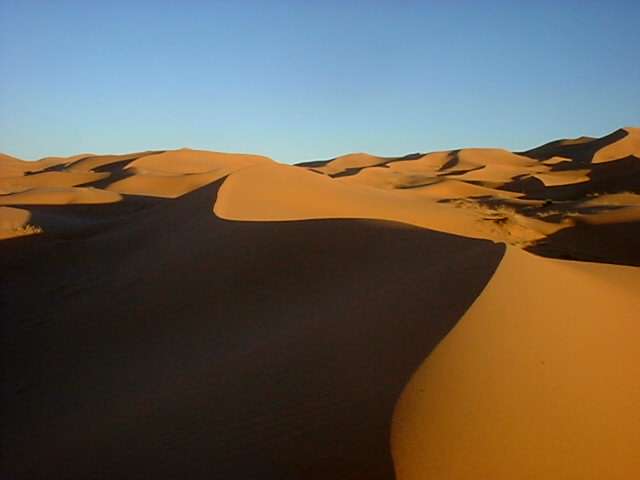 |
Dunes at sunset
Merzouga, Morocco (26Nov00) |
I was awoken by sounds of honking horns, signaling that the buses were about to
leave for the weekly market in Asni. I was in Imlil, a tiny village high
up in the Atlas mountains of Morocco. I had arrived at night, and so all I
could see were the dim lights of the few small shops and restaurants of the
town. When I emerged the next morning, I found a visual treat; all around
towered the snow covered Atlas mountains. The air was crisp anda clean,
and it was calm and peaceful. It was the antithesis of Marrakesh.
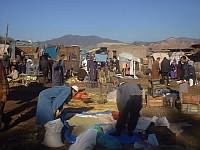 |
Asni's weekly market
Asni, Morocco (18Nov00) |
I was very excited about visiting the market, so I hopped in one of the
minivans making the trip to Asni. Inside the minivan were rows of
tiny benches, and once we were fully loaded and ready to go, I counted
twenty people inside, with an additional five on top. We were packed like
sardines, and as we bounced over the rugged dirt road, I would barely move,
padded by all the bodies around me. Behind me, a man was throwing up, and
it took several minutes before someone managed to locate a plastic bag for
him to use. 45 minutes later, we were all poured out of the minivan and
into the masses swarming around the market.
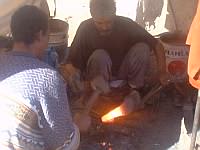 |
The market blacksmith
Asni, Morocco (18Nov00) |
Ansi was a tiny village, but there was a huge field reserved for the weekly
market. One end was reserved exclusively for donkey parking, and row
after row of donkeys were lined up, as people rode them in from the
outlying villages. The market had a lot on offer: bales of hay, pots and
pans, pottery for cooking, giant water buckets made out of recycled tires,
and of course, food supplies. There were augerbines and carrots, potatoes
and tomatoes, onions and lettuce. Every few stalls had enormous bags of
spices, including cumin, cayanne, and turmeric. There was also an
impressive selection of dates and figs.
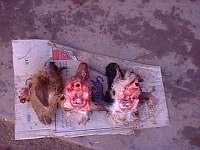 |
Only 200 Dirham each
Asni, Morocco (18Nov00) |
In the butchery section, goat seemed to be the meat of choice, and
everything was available; livers, intestines, legs, whole heads.
Everything you needed to build your own goat, carefully strung out for
display. A whole goat head went for about 20 Dirhams (~US$2.)
Besides food, services were also available, including medical care and
barber services. The doctor and waiting patients all sat on the dirt floor
of a small room. One by one, the patients would sit next to the doctor for
treatment. The most common injury was a sprained ankle, incurred no doubt
from stepping in a hole while trying to herd goats. The doctor would start
by violently twisting the injured ankle back and forth. Then he would
apply a cloth which had been dipped in boiling water, and finally he would
tightly wrap it with a piece of dry cloth. He then moved to the head,
passing his hands carefully over the head like a fortune teller using a
crystal ball, until he found just the right spot. He then yanked out a
small tuft of hair. He repeated feeling the head and, yank, out came
more hair. The pace picked up, and soon it seemed that all he was doing
was yanking out hair like a barber with no scissors. Luckily, the barber
did indeed have scissors.
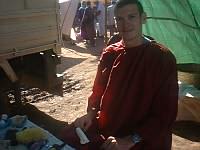 |
A Berber barber haircut
Asni, Morocco (18Nov00) |
The barber worked right out in the open, with a small tarp for cover. I
was long overdue for a cut, so I decided to give it a try. I sat down,
and in a matter of seconds, scissors were whirring around my head and hair
began to rain down. I took a look in the mirror, and managed to stop him
just before he cut off the last tiny piece of hair I had left in front. It
appeared that there was only one Berber haircut, and it was short.
Throughout the day, one of the locals followed me around, describing in
broken English what was going on: "This is rice. These are potatoes."
The running commentary wasn't particularly helpful, but he insisted on
following me around, and I was busy taking pictures. I knew that it would
come at a price, however. Good deeds towards tourists in Morocco are rarely
acts of pure kindness. Indeed, as I finally bid him farewell, he tried to
sell me some cheap trinkets for ridiculous amounts of money. Things he was
claiming were hand made goods from local tribes and he wanted 200 Dh for
were identical to the junk people were selling in the market for 1 Dh. I
politely told him that I wasn't interested, but he kept pushing. He said,
"I need money to buy sugar and rice for my family." "Fine," I said, "Let's
go right now and I'll buy you some sugar and rice." He declined my offer,
which made it clear his intentions weren't entirely above board. I
eventually gave him 30 Dh and sent him on his way.
After a full day of wandering the market, I squeezed back into a minivan
and headed back to Imlil. While certainly a nice place to relax for a few
days, Imlil was not my final destination. It was the starting point for a
two day hike to the peak of Toubkal, the highest point in north Africa.
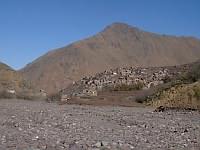 |
On the road to Toubkal
Aroumd, Morocco (19Nov00) |
The trail to the warming hut for Toubkal reminded me a lot of hiking in
Nepal; narrow rocky trails cut into the sides of steep, barren hillsides.
In the backdrop towered the snowcapped peaks of the High Atlas mountains.
Along the way, small villages dotted the landscape. No matter how tiny the
village, it was certain to have a mosque. One tiny village, too small for
a large minaret, simply painted a giant rock to mark the location of the
mosque.
The walking was very peaceful, with only an occasional farmer and donkey
along the way to break the solitude. Near the end of the day, I met up
with a French couple, Cedric and Natacha, who were also making the ascent
to Toubkal. Once we reached the warming hut, we met a third Frenchman,
Vincent, a mountain guide from Chamonix.
The French connection was not accidental; during the colonization of
Africa in the beginning of the 20th century, France gained control of much
of Morocco. While retaining power only until 1956, France had a large
impact on Morocco, building villes nouvelles (new cities,) roads, and
railways. French has also become somewhat of an official second Language,
with almost all signs written in Arabic and French.
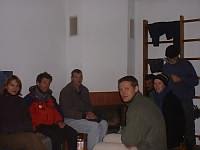 |
The warming hut
Toubkal, Morocco (19Nov00) |
As a result, Morocco has become one of the few places in the world that the
French feel comfortable visiting. Seeing that the French are avid climbers
and hikers, the French Alpine Club had build a large and modern warming hut
at the base of the mountain. While not exactly luxurious, it did have the
essentials; running water, a fireplace, kitchen facilities, showers, and
bunk beds. The place looked equipped to handle about 30 or 40, but since
it was wintertime, there were only six of us. Owing to economics only the
French could understand, the prices for accomodation soar during the winter
when occupancy is lowest. The price for a shared bunk (not including
firewood for heating) far exceeded the price for a single room anywhere
else in Morocco. Location, location, location.
The final ascent was straightforward enough; a few places requiring
carefully placed steps on ice and snow, but overall just an agressive hike
up a steep, rocky trail. From the top, the hightest point in north Africa
at 4300 m, you could see the jagged peaks of the Atlas mountains yield to
the low, rolling hills of the Anti-Atlas, and eventually desert.
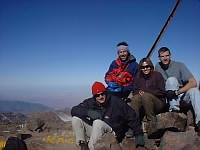 |
Vincent, Cedric, and Natacha
Toubkal summit, Morocco (19Nov00) |
Back in Imlil, I hitched a ride with the French all the way back to
Marrakesh. From there, I said my goodbyes and headed out on my own again,
bound for the southern gorges. Transportation in Morocco is unique. The
buses are no different than in most third world countries; giant lumbering
boxes of rattling metal, which idle for hours until they are packed to
suffocation, then stopping every five minutes. But they also have an
alternative; the gran taxi. The gran taxi is a communal taxi, invariably
an old, beige Mercedes diesel sedan, which would make fast point to point
trips once enough people wanted to go to the same place. Enough was
defined by Moroccan standards of economy and comfort, which meant six
passengers; two in the front passenger seat and four in the back.
Taking a gran taxi is a great way to really get a sense of who Moroccans
are, far away from the scamsters and peddlers of the big cities. Being in
a communal taxi meant more than just sharing a cab. The trip to Ouazazate,
the transit hub of the area, was over four hours, so along the way, we
stopped for lunch. Four of us, including the driver, all sat down and
shared a Taigene, a very typical Moroccan dish. It is a stew of tomatoes,
potatoes, carrots, onions, goat, and spices, slow cooked in a huge cone-
shaped crock. It wasn't my first taigine in Morocco, but sharing one with
others taught me the subtleties of eating it; you don't use any utensils,
only bread and your hands. First, you start by eating the caramelized
onions, soaking up as much juice as possible with each piece of bread.
Then you eat the carrots, tomatoes, and potatoes, and finally, the meat.
Our driver carefully tore all the meat from the bones for us. The bread
just kept coming, and the meal wasn't finished until the bowl was wiped
completely clean. Mint tea was, of course, served alongside.
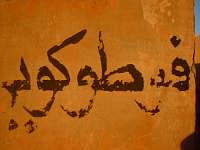 |
It says 'photocopy'
Boumalne du Dades, Morocco (22Nov00) |
Once in Ouazazate, I had to change taxis, heading to Boumagne du Dades. I
arrived just as the sun was setting. Through the window of the cab, past
the two people sitting next to me, I could just make out the last rays of
light lighting up the mud buildings on the horizon. It was one of the most
amazing images I've seen, but being able to get out of the cab, all I could
do was admire as the sun finally faded away.
My reason for going to Dades was to see Dades Gorge, a supposedly beautiful
narrow gorge cut through glowing red rock. To get there, you had to take a
communal taxi an hour or two from Boumagne and then hike for an hour. The
"taxi" was quite a piece of work, with the door held closed with an old
bike tube, and a bike spoke used as a lock mechanism on the opposite door.
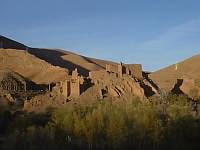 |
Kasbahs
Ait Arbi, Morocco (23Nov00) |
The trip through the valley leading to the gorge was like a journey to
another planet. The valley walls were bright red dirt and rock, and built
up into the hillsides were ancient crumbling casbahs, once fortresses for
local royalty. The casbahs were built out of the same soil, and they
looked like giant sand castles.
As we headed deeper into the valley, we would pass once casbah afer
another. Eventually, we arrived at a small village, which was where the
road, and consequently the taxi ride, ended. It was less of a village than
just a few hotels catering to the tourists who would come to visit the
gorge. Every person there tried to sell me a "tour" of the gorge - a hike
in the gorge, tea with a nomad, etc. It all sounded so packaged, so I just
headed off on my own, hiking with just my camera and a bottle of water.
I didn't find much. It was nice to get out on my own and hike, but all
there really was to see was a small valley cut through the soft, red rock.
The taxi service back to Boumagne was spotty as best, and I was told that
the last one left at 3, so after an hour or so of hiking, I headed back.
After waiting from 2:30 to 4:30, I began to realize that I may not be
making it back to Boumagne after all. Out of curiosity more than anything
else, I started walking down the road into a nearby village. By 5, it was
almost sunset, and I was starting to become uncomfortable with my lack of
any plan for accommodation. But I had faith that it would work itself out
somehow, and indeed, moments later a taxi passed by. I had already
resigned myself to sleeping without any of my things, which had been left
in Boumagne, so suddenly the desire to make it back to town that night
didn't seem that great. As we wound our way back through the valley of
sandcastle casbahs, I became enamoured with the idea of staying in the
valley for the night. As soon as I saw a sign for a hotel, I decided that
I wanted off, so I had the taxi stop, and I got out. I was in the village
of Ait Arbi, which consisted of little more than a few mud houses and a
hotel, but the views of the surrounding valley were stunning.
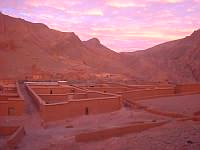 |
The red dusk
Ait Arbi, Morocco (22Nov00) |
With lots of cloud cover, I had written off a sunset, but just at the very
last moment, the sun broke out from the clouds and bathed the hills in warm
light. The result was magical. Everything lit up in bright red, and just
as the sun disappeared, everything glowed a dark pinkish-red.
It was Thanksgiving Day in America, and as much as I enjoyed sharing
Taigine with the people who ran the hotel, I really wanted to say hello to
my family. Luckily, there was a phone in town, so one of the workers in
the hotel went to find the owner of the telephone booth so that he could
come over and unlock it. Three minutes of frantically feeding coins into
the phone and my finances were depleted, but it was great to hear voices
from home, even if only for a few minutes.
I was the only guest in the hotel, which only had a few rooms to begin
with, and the window in my room looked right out on the valley. I could
poke my head out and track the progress of the sunrise without having to
even leave my bed.
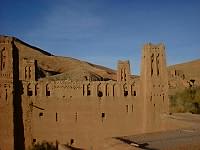 |
Kasbahs
Ait Arbi, Morocco (23Nov00) |
My original plan was to leave early in the morning, but I became so
enchanted with the beauty and quiet of Ait Arbi, that I stayed the whole
day, eating sliced oragnes and cinnamon on the deck and wandering around
the nearby villages.
The villages were simply collecions of small mud brick houses and fields
with nothing but small trails connecting them. Young girls would lead
donkeys carrying water back and forth between the houses. And on the
roof, sheltered in their own mud brick boxes, were satelite dishes.
I caught the afternoon taxi with no problems, and took it all the way back
to Boumagne du Dades, with plenty of extra time to go back searching for
the spot where I had seen the sunset from the taxi two days earlier. I
was treated to a repeat performance.
My tour of the southern gorges continued, and I headed towards Tinenhir,
gateway to Todra gorge. In order to save money, as well as to get a well
rounded Moroccan travel experience, I decided to take the bus. We made it
about 1/2 km before getting a flat tire. We were on a hill, so in order to
keep the bus from rolling away while they changed the tire, they pulled one
of the bench seats out of the bus and used it as a chock for the tire. An
hour later, the tire was repaired, the seat reinstalled, and we were
rattling down the road into the dark of night.
After spending the night in Tinenhir, I took another communal taxi through
the valley leading to Todra Gorge. The valley was similar to Dades gorge,
but running through the center of the valley was a river of palm trees,
their green fronds lapping against the red mud buildings built along the
valley walls.
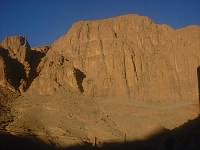 |
Todra gorge
Todra, Morocco (25Nov00) |
The gorge itself was spectacular; only 20 m. wide in the narrowest parts,
the red rock walls reached straight up for 100 m. before yielding to the
blue of the sky. Even at midday, the floor of the gorge, through which
wound a calm creek, was in shadow. The area was a climber's paradise, and
so I felt obligated to give it a try, but lacking good equipment and money
to burn, I didn't do more than a handful of short climbs.
There was a very nice hotel right in the center of the gorge, but it was
far too luxurious for my taste. I loved the location, however, so I paid
40 Dh (US$4) to sleep in a giant Berber tent which was pitched next door to
house the busloads of tourists who flooded the gorge everyday for lunch as
part of their package tour.
The next day I continued my trek eastward, this time taking a series of
minibuses in short hops from town to town. Each trip was an adventure in
its own right. The first bus, after stopping for 20 minutes while waiting
for passengers, traveled all of two km. before stopping at the next service
station for repairs and lunch.
The next bus began in the town of Erford. We waited for an hour or so in
teh sweltering heat while they recruited enough passengers to fill every
square cm of space. While waiting, I made myself useful by helping load
things onto the roof of the bus. The Moroccans found my height quite the
novelty, and soon everyone was requesting that I lift their goats, sacks of
potatoes, or whatever on top. Inside, the minibus was a sweat lodge on
wheels. It was ridiculously crammed full, with 30 people in a space made
for half the amount, and everyone was shedding buckets of sweat. During
the two hour trip, passengers would load and unload through windows, doors,
and the back to avoid having to penetrate the mass of bodies. It was a
long two hours.
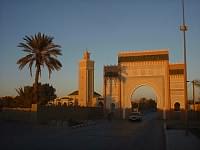 |
Sunset in Rissani
Rissani, Morocco (25Nov00) |
Even the dirty, smoky air of Rissani seemed fresh in comparison. Rissani
was a dirty, nasty place, and I really didn't want to spend the night
there, but I was having a hard time finding transportation for the last 20
km. to Merzouga. Merzouga, the town on the edge of the desert, was
supposedly a great place to relax for a couple of days. Thanks to a
connection I made in Tinengir, I was supposed to be picked up in Rissani
and driven to Merzouga, but their car supposedly broken down. Eventually,
desperate to escape, I forked up the 100 Dh necessary for a private taxi.
It was not your average taxi ride. The taxi itself was a bright
orange truck, and the driver had an orange turban which matched perfectly.
For some reason, once I had agreed to pay for the trip, half of the people
at the cafe I had been waiting at decided to join along for the ride.
The trip took over an hour, and was entirely off-road. There was a tangle
of tire tracks cut through the sand and rocks, but the driver, who clearly knew
where he was going, jumped confidantly from one track to the next in the
pitch dark and at an alarming speed. Soon the lights of Rissani were just
a dot on the horizon, and we were in complete darkness.
Once we got to the hotel in Merzouga, the entire truckload of passengers
got out, and proceeded to join me in a giant tee and taigene feast. There
were seven of us in all, and it was great fun. It was a beautiful night,
and so I opted to sleep on the roof of the hotel, and I feel asleep staring
at the stars.
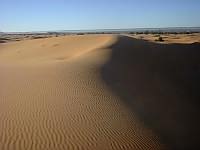 |
The dunes of Merzouga
Merzouga, Morocco (26Nov00) |
I was stunned at sunrise. I had arrived in town in the pitch dark the
night before and I couldn't see anything, but as the sun rose, I could see
why my friend had so strongly recommended going to Merzouga; just a few
hundred meters away stood a sea of huge, glowing, golden sand dunes.
Merzouga was on the very edge of the desert.
There really wasn't much to do in Merzouga itself, and the draw of the
desert was overpowering, so I decided, as touristy as it sounded, to
arrange a two day camel trip into the desert. It was an experience I will
never forget.
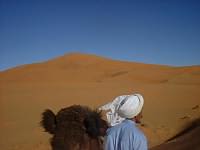 |
Camel view
Merzouga, Morocco (26Nov00) |
It was just myself, two camels, and my guide Ali, a hard working man with a
lazy eye and a weathered face. Ali spoke no English or Spanish and I spoke
little Berber, French, or Arabic, so it was a very quiet trip. Most of my
time was spent concentrating on balancing myself and my camera gear on top
of the camel as it plodded up and down the dunes.
Once away from the city, all I could see in any direction was sand;
beautiful, fine, red sand, which glowed brightly in the setting sun. The
dunes themselves were like nothing I'd ever seen in my life; almost a
hundred meters high, they came to a razor sharp peak at the top, and the
difference in light from one side to the next was dramatic.
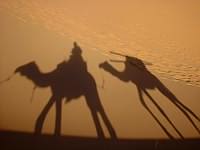 |
Riding high
Merzouga, Morocco (26Nov00) |
Taking photographs was challenging, since a single foostep could be seen
even a hundred meters away, as it would break up the perfect surface of the
dune. Even breathing on the top ridge of the dune would dull the sharpness
of the ridgeline. I had to carefully plan each step to keep from
"ruining" the sand.
As sunset turned to night, I prepared to sleep. There was a small tent
setup for sleeping, and I assumed I would be sleeping in it. I wanted to
watch the sunrise from the top of the highest dune, which towered above us,
so I gestured to Ali by pointing to the top of the dune. He immediately
started piling blankets on me. He obviously thought I was indicating that
I wanted to hike up in that instant, and sleep on top. It seemed like a
grand idea, so I went with it. I took the blankets from him, and started
the long trudge up to the top. I fell asleep with cool sand on my back and
a sky full of stars.

